
February 28, 2019
Searching for answers in Madagascar
Archaeologist Kristina Guild Douglass ’02 investigates human-environment interaction on this African island nationby Allyson Irish
Kristina Guild Douglass ’02 vividly recalls an ambitious field trip during eighth- and ninth-grade to the Masoala Peninsula, a relatively untouched area in northeast Madagascar. She and her classmates rode bicycles through the coastal and tropical areas, stopping along the way to meet with local community members about environmental issues.
Memories of that trip and the lessons learned about the country’s ecosystem, history, and people deeply moved Douglass and are part of the reason she is so intent on continuing her research in Madagascar and partnering with its citizens.
“I saw how people, especially in rural areas, did not have a say ultimately in how things were developed. That trip convinced me that the people who have the most expertise and the biggest stake in conserving and helping the local landscape are the people who live there,” Douglass says.
Now an assistant professor of anthropology at Penn State, Douglass says that field trip and the memories of living in Madagascar from age 10 until arriving at Phillips Academy in 10th grade form the foundation of her work. She believes her research in Madagascar may hold the key to some important findings about our interactions with the environment and how we can use this knowledge to improve the future.
In 2011, as a doctoral student at Yale, Douglass founded the Morombe Archaeological Project in southwest Madagascar. The project combines archaeology and anthropology in site surveys and oral histories to uncover how ancient peoples interacted with the environment and to determine if these interactions might actually have been symbiotic instead of harmful.
“Some may think that people arrived and then immediately caused environmental degradation. This suggests the best way to save the environment is to keep people out,” Douglass says. “People being in a place doesn’t necessarily mean they will use all of the resources.”
It’s an unusual concept and one that Douglass combines with an equally unusual approach. While many archaeology and anthropology methods focus on proving a thesis by gathering data from the land and its people—often with contention, Douglass instead collaboratively involves those who live there.
I want to have an impact on people's lives today.
”
This approach, often called community-based participatory research, was recently featured in the journal Nature article, “How three research groups are tearing down the ivory tower.” Through the Morombe Archaeological Project, Douglass employs Malagasy men and women of all ages, many of whom cannot read or write. In addition to teaching team members how to excavate, analyze ceramics, and other scientific tasks, Douglass also provides some remedial instruction.
Despite these challenges, Douglass is proud to utilize a process that is more equitable for all.
“I want to have an impact on people’s lives today,” Douglass says. “My work has to have meaning for people whose lives were impacted and for those whose lives are currently tied to the landscapes we are studying.”













